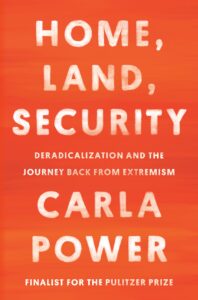
On Extremism, Terrorism, and the Words We Use to Foster Division
Carla Power Navigates the Line Between "Us" and "Them"
Figen Murray didn’t see evil in the suicide bomber’s face, even though he had killed her son Martyn and 22 others. For days after the Manchester attack, she didn’t watch or read the news, so as to avoid seeing the bomber’s mug shot. But two days after Martyn’s death, she caught a glimpse of the bomber’s face by mistake, accidentally walking past a stack of newspapers with his picture on the front. She instinctively turned away, but even then, she said, “there were only three words in my mind: ‘You foolish boy.’ ”
The face she saw didn’t look evil, just clueless. “They may have chosen a really rubbish picture of him, but honestly?” said Figen, when we spoke on the phone a few months afterward. “He looked a bit gormless. As though he wasn’t all there. I just kept wondering, ‘What on earth were you thinking?’”
The police she talked to in the weeks that followed insisted the bomber knew what he was doing, but the mother of five disagreed. “I’ve got kids,” she said. “Twenty-two years old? They don’t know what they are doing at that age. Although he murdered my son, I cannot be cross with somebody who blindly followed some rubbish they were fed, and then was stupid enough to die for it.”
Where did Figen’s sense of understanding come from? Perhaps it helped that she was a thrice-over immigrant who had been raised the daughter of Turks in Germany, then later settled in England. Perhaps her work as a counselor professionally trained her to pick her words carefully. In any case, she resisted using the language of division from the beginning.
Them. Another word of division, another favorite of the more excitable press.
A few weeks after the bombing, when a top counterterrorism officer visited her house, Figen was saying something about the 23 people who’d died that night, when the officer corrected her: “No, it was 22 people who died.”
“Well, the terrorist died too,” Figen responded.
“Oh, we don’t count perpetrators in the police,” the officer said.
“Well, he was still a human being,” said Figen. “He was somebody’s child.”
“It’s very noble of you to think that way,” she remembers being told. “But we don’t think that way about them.”
*
Them. Another word of division, another favorite of the more excitable press. (now they kill our little girls! screamed one front-page headline, despite the fact that the bomber, Salman Abedi, was Manchester-born.)
Even in death, the terrorist is rendered invisible, uncounted, ignored.
In the weeks following the bombing, Figen continued to step over the border between Us and Them. She deliberately flouted it after another terrorist attack occurred just a few days before Martyn’s funeral. A man drove his car into a crowd near a London mosque, screaming that he wanted to kill all Muslims, and he succeeded in killing one person. A crowd surrounded the culprit and beat him until the mosque’s imam and worshippers formed a cordon, protecting him until the police arrived.
Figen saw a photo of the scene, and moved by the men’s unwillingness to let anger descend into mob violence, she decided to forgive the man who’d killed Martyn. A public display of forgiveness from a mourning mother, an immigrant who was born a Muslim, would undermine the tidy Us versus Them narrative being pushed by zealots and populists. A month after the bombing, she called the BBC and went on a breakfast show, forgiving the suicide bomber during the broadcast. The best response to the bombing, she told me later, was refusing division and bitterness. “Terrorists want anger and chaos and hate,” she said calmly. “I refuse to give it to them.”
A public display of forgiveness from a mourning mother, an immigrant who was born a Muslim, would undermine the tidy Us versus Them narrative.
She has paid for her restraint. Online trolls told her she didn’t look like a grieving mother, because she smiled too much. One Twitter user wrote, “With that attitude, your son deserved to die.” In the years since the bombing, Figen has gone on to study for a graduate degree in counterterrorism, eager to understand why people join militant groups, not least because “we have all taken part in creating these monsters, as a society.”
*
The creation of monsters became a growth industry after 9/11. The attack spurred the United States to embark on what the Bush administration called the War on Terror. Between 2002 and 2017, the U.S. government spent 16 percent of its discretionary budget—around $2.8 trillion—on counterterrorism efforts, including its wars in Iraq, Afghanistan, and Syria. It expanded its powers of surveillance and imprisonment at home, and its rights to assassinate both its own citizens and foreigners abroad. The securitized response to terrorism hasn’t worked: between 2000 and 2014, the number of jihadist militants tripled, from 32,200 to over 110,000, according to the State Department and Stanford University’s Mapping Militant Organizations project, and global deaths from terrorism increased ninefold. During the so-called War on Terror, the seven countries the United States either invaded or conducted air strikes in suffered a 1,900 percent rise in terror attacks, compared to a mere 42 percent rise in other Muslim-majority countries, found analysts A. Trevor Thrall and Erik Goepner in a study for the Cato Institute.
On both sides of the Atlantic, the polarized view—dividing the world into pure versus evil—has metastasized. No longer is it applied simply to those deemed foreign enemies, but increasingly to fellow countrymen and neighbors as well. During the month after Britain’s 2016 vote to leave the European Union, racially and religiously motivated hate crimes rose by 41 percent. Divide and divide and divide again: we see it in our cities, and suburbs, in privatized police and fire forces, in gated communities. We see it online, in Tweet-size shrieks and Facebook posts that bay and carp. We see it in Washington. Increasingly, we think like census takers or focus group facilitators, flattening our fellow citizens to single dimensions: Black, Latinx, or white, native-born or migrant, members of the 1 percent or of the other 99, Republican or Democrat. Like our elected representatives, we stick more closely to our political tribes than ever.
During the so-called War on Terror, the seven countries the United States either invaded or conducted air strikes in suffered a 1,900 percent rise in terror attacks.
We all have our own Other, our personal version of Them. Would I, for instance, listen as closely and hard to the story of a neo-Nazi, or to that of an End of Days cultist, as I would to that of a jihadi? I’d like to think I would, but I’m not so sure. My own complicity in the creation of everyday Others struck me on a visit one day back to my hometown, St. Louis. At a grocery store, my 14-year-old daughter Nic and I ran into an acquaintance from my old neighborhood. After we’d exchanged pleasantries and moved on, Nic leaned over and murmured: “Do you think she could be a Trump supporter?”
I paused, considered, and guessed, “She might well be.”
Nic turned to stare at the woman’s receding form, her eyes as wide as if she’d seen a golem lurking in the frozen foods aisle.
Since the attacks on the World Trade Center, the Islamist terrorist has been framed as the ur-Other, a catchall receptacle for free-floating anxieties about everything from migration to globalization to waning Western power. Whether as a Guantanamo inmate, or a target of American drone airstrikes, or an Islamic State fighter, the jihadi lives—in law as well as in the imagination—beyond the boundaries of civilized society. The Bush administration’s use of the term unlawful enemy combatant allowed it to detain and interrogate terrorist suspects without being hamstrung by Geneva Convention rules. After the destruction of ISIS’s so-called caliphate, countries around the world debated whether the fifty thousand–odd foreign fighters in Syria should be repatriated or left to fend for themselves in refugee camps. The frank language deployed by some Western leaders stripped the fighters of any humanity, as when Britain’s defense secretary announced that his government should “bring destruction” to anyone fighting in Syria, on grounds that “a dead terrorist can’t cause any harm to Britain.”
Even the spectacularly urbane Rory Stewart—a former British government minister who speaks nine languages, taught human rights at Harvard, and set up a nonprofit for artisans in Afghanistan—responded to the threat of returning foreign fighters from Syria thus: “Unfortunately the only way of dealing with them will be, in almost every case, to kill them.”
When I read that statement, all I could think of was those infamous four words from Joseph Conrad’s Heart of Darkness. At the end of his report on Africa for the (fictional) International Society for the Suppression of Savage Customs, the onetime sophisticate Kurtz scrawls: “Exterminate all the brutes.”
*
Defining terrorist has always been been an inherently politicized process, of course. Who gets called “terrorist” and who is deemed, say, a “freedom fighter” depends on who is doing the calling, and when. The U.S. Army once tallied over one hundred definitions of terrorism, which makes sense when one glimpses the ways that the powerful use or abuse the term. Jonathan Powell, a lead negotiator in the Northern Ireland peace process, observed that terrorism is “something used by governments to instill fear at home, or support the enemies of their enemies abroad.” Back in the 1980s, Osama bin Laden was among those “freedom fighters” whom Ronald Reagan praised so effusively for battling the Soviet empire in Afghanistan. During the struggle against apartheid, the South African government imprisoned Nelson Mandela as a terrorist. In 2020, Saudi Arabia’s terrorism tribunal found Loujain al-Hathloul, an activist who’d campaigned for women’s right to drive, guilty under its counterterrorism and terror finance laws.
The words extremist and radical, too often carelessly tossed together with terrorist, have suffered similar deployment for political causes. From 2017 to 2019, the FBI fashioned the new category of “Black Identity Extremist” to target activists they claimed were fomenting violence. Russia has banned the Jehovah’s Witness sect on grounds of being “extremist.” Chinese officials claim that the million Uighur Muslims in mass internment camps are enjoying so-called deradicalization. In 2019 the UK government, having tried for years to nail extremist as a legal term, finally had to give up, so elusive was the definition.
In 1963 the Rev. Martin Luther King, Jr., despairing of how white moderates had labeled his actions “extremist,” pointed out from his cell in the Birmingham jail that extremism had an honorable legacy. If he was an extremist, then Paul, Martin Luther, and Jesus were, too. What’s more, King’s so-called “extremism” was a response to a Southern regime that relied on terrorist bombings and lynchings, an apartheid system girded not just by custom and law but by the ever-present threat of violence. Nearly all extremism is relative; what you define as extreme depends almost entirely on where you stand.
The Rev. Martin Luther King, Jr., despairing of how white moderates had labeled his actions “extremist,” pointed out from his cell in the Birmingham jail that extremism had an honorable legacy.
And when. Today’s statesman is often yesterday’s terrorist plus time. Reflecting on how Realpolitik can make former militants respectable, the mid-20th-century British politician Hugh Gaitskell once quipped, “All terrorists, at the invitation of the government, end up with drinks in the Dorchester [Hotel].” To be sure, not all terrorists turn into statesmen, as the historian Michael Burleigh has observed: “If you imagine Osama Bin Laden is going to evolve into Nelson Mandela, you need a psychiatrist rather than a historian.” Still, the case of the former IRA leader Martin McGuinness shows that former terrorists can craft lives with second acts. The IRA chief of staff became a peacemaker in the 1990s and, eventually, Northern Ireland’s deputy first minister. On his death in 2017, the man who’d once commanded paramilitaries killing British soldiers received tributes from world leaders, including Queen Elizabeth herself.
Former enemies may be allowed makeovers, but current ones are rarely portrayed as capable of reform. After every terrorist attack in the West, the media tell the story of the perpetrator’s journey—a bildungsroman that inevitably ends in violence. When a boy joins Al Shabab or Al Qaeda, or when a girl sneaks off to join ISIS, they are effectively dead to us. Having joined a listed terrorist organization, they are no longer dynamic human beings but static targets. Unless they become the subject of a manhunt or a court case, they are forgotten. Once a terrorist, always a terrorist, goes the dominant narrative, until they’re killed or jailed.
*
Thinking about the question that the young woman posed that day in Austin, it occurred to me that I’d been willfully dainty about terrorism, radicalism, and extremism. I had first gone into journalism to write stories that make the purportedly alien less so. In a world shrunken by migration and technology, I’d always wanted to try to understand not just those constructed as Others but the systems and assumptions that went into their design as such. I was less interested in arguing certainties than in teasing out processes and complications. Above my desk, I tacked a Post-it note with the filmmaker Jean Renoir’s observation “The truly terrible thing is that everybody has their reasons.”
So why had I stopped short of inquiry when it came to people drawn into militant Islamist groups? If I truly wanted to chart similarities between people with a range of worldviews, surely I should search for common ground not merely with a kindly, quietist Islamic scholar, as in my first book, but with those who engaged in violence. To avert my eyes from the ugly or troubling was to shut down true exploration. It created a closed system of certainties, a liberal’s version of Vice President Dick Cheney’s hard-ass dictum: “We don’t negotiate with evil; we defeat it.”
Worse, by refusing to engage fully with terrorists—or even with those who weren’t violent but were considered “radicalized”—I was feeding the monster. By turning away from people who fomented discord, I was leaving their “evil” intact. Unexamined and unexplored, the people who got flattened into “terrorists” remained unexplained, their monstrousness unchallenged. And it had become increasingly clear that we had entered an age where conflicts no longer consisted of disputes among quiet practitioners of faith and ideology. If we didn’t reckon with the extremists on all sides, we abandoned any hope of bridging conflict in this radicalized age.
Unnerved enough by the young woman’s question to feel an inchoate dereliction of moral duty, I thought about an earlier trip to Texas, when I’d visited the Rothko Chapel in Houston, a space for contemplation for people of any and no faith. Inside are Mark Rothko’s famous fourteen black paintings. The day I visited, it was bright outside, so that walking in, I found the paintings to be merely huge blocks of plum or black. It took a while for my eyes to adjust, to start to see the depth and movement in paintings that had at first seemed flat, even oppressive. Rothko, who described the six years of working on the paintings as “torment,” said he wanted to paint “something you don’t want to look at.”
To look at something I didn’t want to look at—that was imperative, I decided as I fell asleep. What would I learn if I turned to face these monsters, if I engaged with people who had been cast as the ultimate Others? What could encounters with those who’d embraced intolerance teach us about our own intolerances, our own imaginative limits? Could learning about their paths into extremism and then out suggest ways we might fix our own polarization and extremisms?
I began to interrogate what we mean when we talk about Islamist terrorism, by talking to jihadis and to those who have worked to help them leave violence behind, whether parents, parole officers, counselors, or mentors. And while the focus of my investigation is on jihadist militants, it’s also a broader, more urgent quest: to see how the Other gets made and—sometimes, with luck—unmade.
__________________________________

Excerpted from Home, Land, Security by Carla Power, Copyright © 2021 by Carla Power. Excerpted by permission of One World, an imprint and division of Penguin Random House LLC, New York. All rights reserved. No part of this excerpt may be reproduced or reprinted without permission in writing from the publisher.
Carla Power
Carla Power is the author of If the Oceans Were Ink, a finalist for both the Pulitzer Prize and the National Book Award. She began her journalistic career at Newsweek in the 1990s. Her reportage and essays have appeared in numerous publications, including Time, The New York Times, Foreign Policy, Vogue, Vanity Fair, and The Guardian. She lives with her family in East Sussex, England.



















